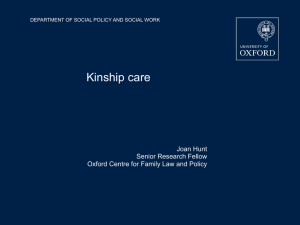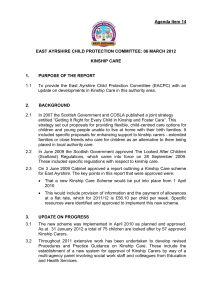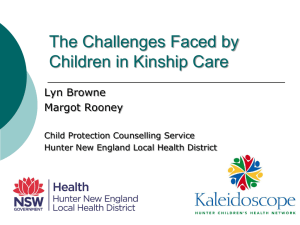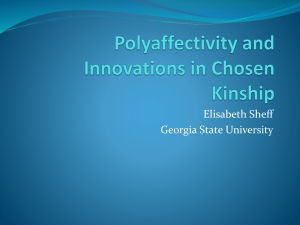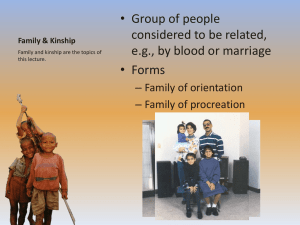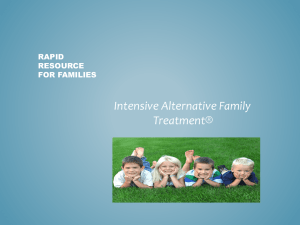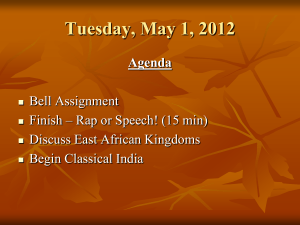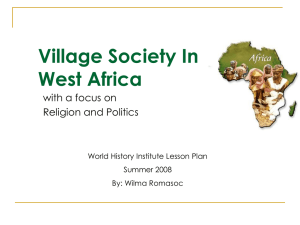Young and *care-full*: Young kinship carers research project
advertisement
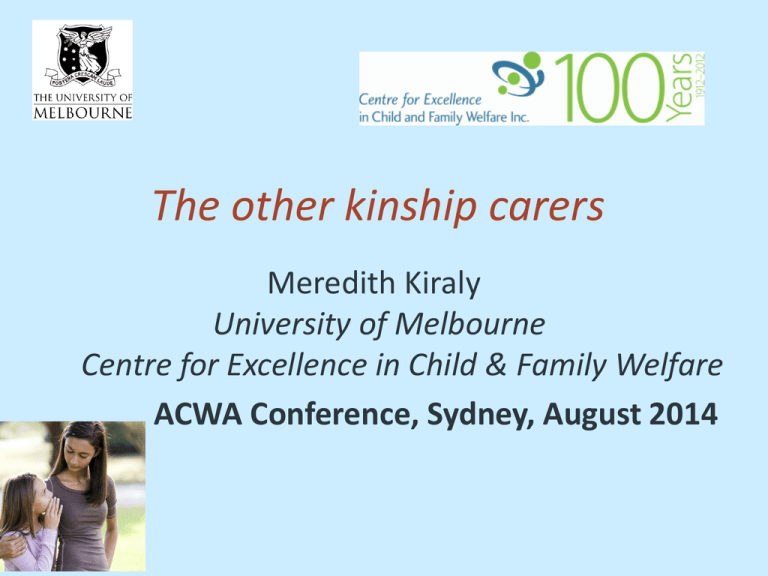
The other kinship carers Meredith Kiraly University of Melbourne Centre for Excellence in Child & Family Welfare ACWA Conference, Sydney, August 2014 Kinship care – a few definitions Kinship care ‘Kith and kin care’: Care within the family or friendship network of the child. Grandparent care Kinship care provided by grandparents. Non-familial kinship care Kinship care provided by an unrelated person who is well-known to the child, such as a family friend. In Australia, also sometimes called ‘kith care’. Informal kinship care Kinship care that has been arranged privately between parents and caregivers. Statutory (formal) Protective care where abuse has been care substantiated by Child Protection, provided in an authorised setting such as kinship care, foster care or residential care. Australian foster care and protective kinship care 25,000 20,000 15,000 10,000 5,000 0 2001 2002 2003 2004 2005 2006 Foster care 2007 2008 Kinship care 2009 2010 2011 2012 2013 What matters to children’s wellbeing? ‘ “Permanence” for children means “security, stability, love and a strong sense of identity and belonging”. The weight of evidence, from all quarters, convinces us that the relationships with people who care for and about children are the golden thread in children’s lives. The quality of a child’s relationships is the lens through which we should view what we do and plan to do.’ (The Care Inquiry, 2013,UK) ‘We know what is valued by children, young people and adults who have been in care...They value relationships with people who: • • • • • • are always there for them love, accept and respect them for who they are are ambitious for them and help them succeed stick with them through thick and thin are willing to go the extra mile treat them as part of their family, or part of their life, beyond childhood and into adulthood.’ (The Care Inquiry, 2013,UK) National Framework for Protecting Australia’s Children Council of Australian Governments, 2009 A significant focus on grandparent care and kinship care more generally: ‘Support grandparent, foster and kinship carers to provide safe and stable care.’ National Research Agenda for Protecting Children 2011-2014 ‘Kinship care: What does—and should—guide decisions on kinship placements for both Indigenous and non-Indigenous children and young people? What are the potential risks and benefits? What are the needs of kinship carers and how are they best supported? What are the outcomes for children and young people in kinship care?’ Senate Inquiry into Grandparents raising grandchildren 2014: Terms of Reference included: • Practical challenges & support needs • How to better acknowledge and recognise the contribution of grandparent families • Practical measures to provide better support. Spotlight on kinship care • 38% of children in kinship care in England were being cared for by a sibling carer without help from older household members. • About 28% of sibling carers were born outside the UK. • Over half the brothers were partnered (60%). • Most (93%) sister carers were single. 43% had no qualifications. • Most sibling carers were parenting more than one child (avge 2). • 19% of sibling carer households were overcrowded. • Most were either unemployed or in low paid occupations. Young kinship carers I think Richard finds it extremely hard now …they have a really good relationship but there are times when Richard doesn’t want to discipline him any more. He just wants to be his big brother and have fun with him. (Big Bruv Little Sis) Big Bruv Little Sis research project Roth, Lindley et al. (2011). Family Rights Group, London • Literature review • Internet survey • Interviews On the day that my Dad died I had a phone call from my sister…I told the children to get some stuff and come to my house. On the way I spoke to my Mum on the phone…and she hung up on me and then she texted me saying “I don’t want them – you look after them”. (Big Bruv Little Sis) Big sister When Mum was alive I used to always go over there and take them gifts and they just remembered me as a loving sister, but when I took them on I became a terrible monster! I was really stressed out with a lot of things. We’ve had a lot of tears, a lot of arguments. I’ll get “You’re my sister, not my mother, you can’t tell me that.”…now it’s not as bad as it was….I’m still learning every day how to deal with my sisters….It was me on my own for such a long time and then to have two young girls, everything just changed. (Big Bruv Little Sis) Non-familial kinship care I think it is a bit more complex for those who are not family – such as myself (Carer previously fostered child’s sister) Family Links Kith and kin care – who are the ‘kith’? Definition of Kith: people with a pre-existing relationship with a child prior to placement (otherwise known as family friends). Breakdown rate may be higher than kin (family) care. (Sallnas 2004, Perry 2012). In a survey of statutory kinship carers in Victoria one-fifth (20%) of respondents were kith carers (Family Links: Kiraly, Humphreys and Hoadley 2012). Mother of child’s friend This experience has been great, I never planned to be a carer. But having met the young lady on many occasions before she picked us to stay with made a big difference in her fitting in with our family. We are lucky, she is a lovely young lady and we are happy to support her for as long as she needs. Family Links Family friend? The young person was someone who lived in the area. I only knew her to say hello to, before she became homeless and then moved in with me. Family Links The research projects Young and ‘care-full’: The support needs of young kinship carers • Identify young kinship carers (under 30) in Victoria/ Australia. • Estimate prevalence of young carers through Census data. • Explore carers’ characteristics and support needs. • Alert policymakers and community to the issues. • Inform the development of more comprehensive research. It takes a village: The support needs of non-familial kinship carers • Explore the characteristics and support needs of non-familial kinship carers. • Alert policymakers and community support services to the issues. Research methods Young and ‘care-full’ It takes a village • Census analysis. • Survey – Victoria. • Survey – Australia-wide • Interviews with support workers, non-familial kinship carers and young people age 18+. • Interviews with young carers and young people age 18+. • Focus groups: staff of kinship, youth & multicultural support services. • Focus groups with kinship care support staff. • Further funding applications needed. • Projects report mid-2015. Kith care – the current survey I was a Teacher’s Aide with child 1. Because of suicidal issues I gave her my contact details if she needed to chat. One day DHS contacted me and asked if I would care for the 3 siblings, I said probably and had the kids 2 hours later. I work as a chaplain at a Secondary College and the young person needed somewhere to live. I offered for the young person to stay with me until something more permanent could be sorted, she has now been with us all most 5 years. Australian Bureau of Statistics 2011 census data 3,515 households: Reference Person <16 years older than oldest ‘other related’ U15 child (eg siblings, nephew/niece) • So ‘parent figure’ is under age 30. 9,557 households: Reference Person 60+, U15 grandchildren or ‘other related’ U15 children (nephew/niece, great-nephew/niece) Australian Bureau of Statistics 2011 census data 6,895 households: Child 15-17 related as sibling to Reference persons <16 years older. 7,882 households: Child 15-17 related as sibling to Reference persons all ages. The challenge of Young and ‘care-full’ • How to find young carers? • Survey publicity and promotion will be the biggest challenge • Can you help? Questions? Discussion welcome, more information available. Meredith Kiraly: mkiraly@unimelb.edu.au 0400-913659 References Young and ‘care-full’ Roth, D., B. Lindley, et al. (2011). Big Bruv Little Sis: Research findings on sibling carers raising their younger sisters and brothers. London, Family Rights Group. Nandy, S., J. Selwyn, et al. (2011). Spotlight on kinship care: Using Census microdata to examine the extent and nature of kinship care in the UK at the turn of the Twentieth century. Bristol, University of Bristol. ‘It takes a village’ Sallnas, M., B. Vinnerljung, et al. (2004). Breakdown of teenage placements in Swedish foster and residential care. Child and Family Social Work 9: 141-152. Perry, G., M. Daly, et al. (2012). Placement stability in kinship and non-kin foster care: A Canadian study. Children and Youth Services Review 34: 460-465.
